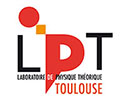Loading...
Derniers dépôts, tout type de documents
Current fluctuations for the one-dimensional totally asymmetric exclusion process (TASEP) connected to reservoirs of particles, and their large scale limit to the KPZ fixed point in finite volume, are studied using exact methods. Focusing on the maximal current phase for TASEP, corresponding to infinite boundary slopes for the KPZ height field, we obtain for general initial condition an exact expression for the late time correction to stationarity, involving extreme value statistics of Brownian paths. In the special cases of stationary and narrow wedge initial conditions, a combination of Bethe ansatz and numerical conjectures alternatively provide fully explicit exact expressions.
The Riemann surface associated with counting the current between two states of an underlying Markov process is hyperelliptic. We explore the consequences of this property for the time-dependent probability of that current for Markov processes with generic transition rates. When the system is prepared in its stationary state, the relevant meromorphic differential is in particular fully characterized by the precise identification of all its poles and zeroes.
After reviewing the peculiar thermodynamics and statistical mechanics of self-gravitating systems, we consider the case of a “binary star” consisting of two particles of size a in gravitational interaction in a box of radius R. The caloric curve of this system displays a region of negative specific heat in the microcanonical ensemble, which is replaced by a first-order phase transition in the canonical ensemble. The free energy viewed as a thermodynamic potential exhibits two local minima that correspond to two metastable states separated by an unstable maximum forming a barrier of potential. By introducing a Langevin equation to model the interaction of the particles with the thermal bath, we study the random transitions of the system between a “dilute” state, where the particles are well separated, and a “condensed” state, where the particles are bound together. We show that the evolution of the system is given by a Fokker–Planck equation in energy space and that the lifetime of a metastable state is given by the Kramers formula involving the barrier of free energy. This is a particular case of the theory developed in a previous paper (Chavanis, 2005) for N Brownian particles in gravitational interaction associated with the canonical ensemble. In the case of a binary star (N=2), all the quantities can be calculated exactly analytically. We compare these results with those obtained in the mean field limit N→+∞.
In this paper, we review and compare the stochastic quantum mechanics of Nelson and the scale relativity theory of Nottale. We consider both nonrelativistic and relativistic frameworks and include the electromagnetic field. These theories propose a derivation of the Schrödinger and Klein–Gordon equations from microscopic processes. We show their formal equivalence. Specifically, we show that the real and imaginary parts of the complex Lorentz equation in Nottale’s theory are equivalent to the Nelson equations, which are themselves equivalent to the Madelung and de Broglie hydrodynamical representations of the Schrödinger and Klein–Gordon equations, respectively. We discuss the different physical interpretations of the Nelson and Nottale theories and stress their strengths and weaknesses. We mention potential applications of these theories to dark matter.
Biohybrid systems in which robotic lures interact with animals have become compelling tools for probing and identifying the mechanisms underlying collective animal behavior. One key challenge lies in the transfer of social interaction models from simulations to reality, using robotics to validate the modeling hypotheses. This challenge arises in bridging what we term the 'biomimicry gap', which is caused by imperfect robotic replicas, communication cues and physics constraints not incorporated in the simulations, that may elicit unrealistic behavioral responses in animals. In this work, we used a biomimetic lure of a rummy-nose tetra fish (Hemigrammus rhodostomus) and a neural network (NN) model for generating biomimetic social interactions. Through experiments with a biohybrid pair comprising a fish and the robotic lure, a pair of real fish, and simulations of pairs of fish, we demonstrate that our biohybrid system generates social interactions mirroring those of genuine fish pairs. Our analyses highlight that: 1) the lure and NN maintain minimal deviation in real-world interactions compared to simulations and fish-only experiments, 2) our NN controls the robot efficiently in real-time, and 3) a comprehensive validation is crucial to bridge the biomimicry gap, ensuring realistic biohybrid systems.
Sujets
Collisionless stellar-systems
Diffusion
Effect relativistic
Physique statistique
Random walker
Cosmology
Einstein
Wave function
Dark matter theory
Dark matter fuzzy
Nanofiltration
Numerical calculations
Smoluchowski-Poisson
Evaporation
Mass
Scattering length
Condensation Bose-Einstein
Gas Chaplygin
Competition
Quantum chromodynamics axion
Scalar field
Entropy
Marcheur aléatoire
Turbulence
Nonrelativistic
9880-k
Energy high
Expansion acceleration
Formation
Effondrement gravitationnel
Computational modelling
Collective behaviour
TASEP
Density
Denaturation
Dark matter halo
Gravitational collapse
Fokker-Planck
Transition vitreuse
Cosmological constant
Dark matter condensation
Mass density
Equation of state
9536+x
Mouvement brownien
Black hole
Computational modeling
Cosmological model
Structure
Bethe ansatz
Axion star
Asymptotic behavior
Dissipation
Halo
Nonlinear
Thermodynamics
Energy internal
Bose–Einstein condensates
Dark matter
Critical phenomena
Gravitation collapse
Statistical mechanics
Collapse
Pressure
Field theory scalar
Chemotaxis
9530Sf
Fermions
Hydrodynamics
Dark matter density
Stability
Collective motion
Galaxy
Axion
Fermi gas
Keller-Segel
Smoluchowski equation
Collective behavior
9535+d
Phase separation
Gravitation
General relativity
Atmosphere
Dark energy
Gravitation self-force
Euler-Maclaurin
Brownian motion
Quantum mechanics
Chemotaxie
Bose-Einstein
Collective intelligence
Kinetic theory
Distributed Control
Energy density
Catastrophe theory
DNA
Electromagnetic
Current fluctuations
9862Gq
Rotation
